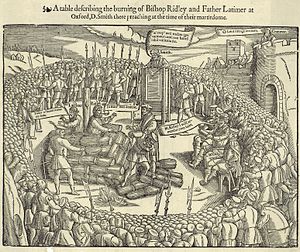Oxford Martyrs
| Oxford Martyrs | |
|---|---|
 The burning of Latimer and Ridley, from a book by John Foxe (1563). | |
| Born | England |
| Died | 1555, 1556,Oxford, England |
| Means of martyrdom | burned at the stake |
| Venerated in | Anglican Communion |
| Feast | October 16 |
The Oxford Martyrs were tried for heresy in 1555 and subsequently burnt at the stake in Oxford, England, for their religious beliefs and teachings.
The three martyrs were the Anglican bishops Hugh Latimer, Nicholas Ridley and Thomas Cranmer, the Archbishop of Canterbury.
History
[edit]The three were tried at University Church of St Mary the Virgin, the official church of Oxford University on the High Street. The martyrs were imprisoned at the former Bocardo Prison near the still extant St Michael at the Northgate church (at the north gate of the city walls) in Cornmarket Street. The door of their cell is on display in the tower of the church.
The martyrs were burnt at the stake just outside the city walls to the south, where Broad Street is now located. Latimer and Ridley were burnt on 16 October 1555. Cranmer was burnt five months later on 21 March 1556.
A small area cobbled with stones forming a cross in the centre of the road outside the front of Balliol College marks the site. The Victorian spire-like Martyrs' Memorial, at the south end of St Giles' nearby, commemorates the events. It is claimed that the scorch marks from the flames can still be seen on the doors of Balliol College (now rehung between the Front Quadrangle and Garden Quadrangle). [1]
Legacy
[edit]There has been an attempt to connect the Oxford Martyrs with the nursery rhyme Three Blind Mice.[2] It has been speculated that the rhyme refers to Queen Mary I of England blinding and executing the three Oxford Martyrs.[3] However, Ridley, Hugh Latimer, and Thomas Cranmer were burned, but not blinded.[4]
A possible interpretation of the 'blinding' refer to the fact that Cranmer believed that by recanting his Protestant faith he would save his life. Only when he realised he would be burnt anyway did he recant his earlier recantation and embrace Protestantism again, just before he was excuted. In some ways Mary could have been said to have blindsided Cranmer by leading him to believe he could save himself and executed him anyway and as such 'cut of his tail with a carving knife.'
Gallery
[edit] |
  |
Notes and references
[edit]- ^ Fodor's Travel Guides
- ^ The Annotated Mother Goose, Bramhall House (1962)
- ^ Espoused by Albert Jack, Pop Goes the Weasel: The Secret Meanings of Nursery Rhymes, Allen Lane (2008). ISBN 978-1846141447
- ^ The Annotated Mother Goose, Bramhall House (1962)
See also
[edit]- Christian martyrs
- Religion in the United Kingdom
- James Brooks, one of the papal sub-delegates in the Royal Commission for the trial
External links
[edit]- 1555 in England
- 1556 in England
- Anglican saints
- History of Oxford
- Christianity in Oxford
- 16th-century Christian saints
- 16th-century Protestant martyrs
- 1555 deaths
- People executed under the Tudors
- Articles about multiple people
- People executed by burning
- People executed for heresy
- People of the Tudor period
- 16th-century English people
